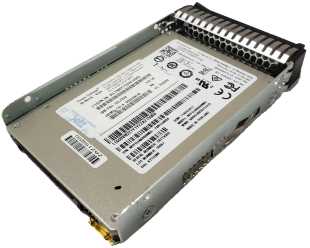Enterprise IBM SSD with eMLC Prices
IBM SSD Price Drop
 SSD prices for iSeries, VIOS and Power AIX systems have dropped so much over the years, making the decision to replace those much slower HDDs very simple. Using Enterprise IBM SSD with eMLC will give queries, applications and other frequently accessed data a significant performance boost. The cost of replacing existing Power system hard disk drives with solid state drives is likely a fraction of what you originally paid for your current hard disk drives. Data you will not likely want to move to Enterprise class solid state drives include sequentially read and rarely accessed data. For read only data that has no more than 1 write per day, can use the much cheaper IBM Mainstream SSD. Refurbished solid state drives are eligible for IBM maintenance contracts, so there is no need to worry about support from IBM.
SSD prices for iSeries, VIOS and Power AIX systems have dropped so much over the years, making the decision to replace those much slower HDDs very simple. Using Enterprise IBM SSD with eMLC will give queries, applications and other frequently accessed data a significant performance boost. The cost of replacing existing Power system hard disk drives with solid state drives is likely a fraction of what you originally paid for your current hard disk drives. Data you will not likely want to move to Enterprise class solid state drives include sequentially read and rarely accessed data. For read only data that has no more than 1 write per day, can use the much cheaper IBM Mainstream SSD. Refurbished solid state drives are eligible for IBM maintenance contracts, so there is no need to worry about support from IBM.Save up to 90% on Enterprise IBM SSDs
Prices for IBM SSDs can be as much as 90% less than IBM list price. IBM’s 3rd generation enterprise solid state drives provide excellent price comparisons, like the ES0D 387GB SSD SFF-2 with eMLC. At the moment, the ES0D SSD is selling for over 85% off IBM list price with warranty. The ES0D Solid State Drive uses IBM’s third generation eMLC technology offering significant performance advantages, providing up to 2X more IOPS capacity and 40% better latency than the previous eMLC SSD generation technology.
IBM Enterprise SSD Drive vs Mainstream SSD
IBM’s eMLC Solid State Drives are what IBM now refers to as Enterprise SSDs, and should not to be confused with mainstream (designed for read intensive applications peforming less than 2 writes per day) SSDs. IBM's 2nd generation eMLC SSDs were also designed to deliver great sustained performance, reliability and longevity, but the enhancements with the 3rd generation eMLC Solid State Drives can provide 24x7x365 usage for 5 years, even while running write-intensive workloads. Actual customer workloads will likely never reach the usage levels IBM used to test their SSDs, so the life span of the SSD should be significantly much greater for every customer.
Newer SSDs for Power9, Power8 and Power7 are a good buy
The newer 4th generation eMLC4 Solid State Drives for IBM Power9, Power8 and Power7 systems also have a great price to performance ROI. A couple good eMLC4 SSD price comparisons are the ES8N and ES8R Solid State Drives. The ES8N 387GB SFF-3 SSD 4k eMLC4 is currently sold for about 80% off IBM list price and the ES8R 775GB SFF-3 SSD 4k eMLC4 is currently sold for less than 50% off IBM list price.
The IBM eMLC4 enterprise SSDs also offer a 1.55 TB SSD, providing twice the maximum capacity of previous eMLC Solid State Drives. Using larger capacity SSD drives, means less SAS adapters. It is important to note, random read-only IOPS performance is only slightly better on eMLC4 SSD compared to the previous generation. However, random write-only eMLC4 IOPS performance is very much worth the investment, as it has increased significantly.
IBM eMLC4 SSDs are supported in Power9 and Power8 system units (SFF-3) and in EXP24S I/O drawers 5887 attached to Power9, Power8 and Power7 servers (SFF-2). Another valuable note about eMLC4 SSD’s, is that they provide SAS 6 Gbps throughput, and capable of supporting 12 Gbps when future SAS adapters come to market.
IBM SSD Installation Planning Guide
https://www.ibm.com/support/knowledgecenter/TI0002C/p8ebk/considerationsforssd.htm
https://www.ibm.com/support/knowledgecenter/TI0002C/p8hal/pxhal_ssdconfig_rules.htm
Read how to move DB2 member, indexes and partition data from disk to SSD using the CHGPFM command: https://www.ibm.com/developerworks/ibmi/library/i-db2ssd/index.html
